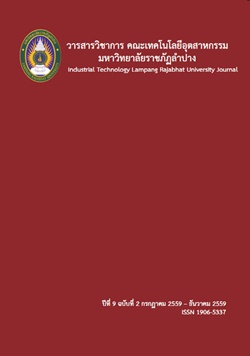12. การศึกษาคุณสมบัติของปูนตำสูตรโบราณเพชรบุรีผสมผงซิลิกา
Keywords:
ปูนปั้น, ช่างปูนปั้นเพชรบุรี, ปูนโบราณ, Stucco, Phetchaburi craftsman, Ancient stuccoAbstract
การวิจัยนี้เป็นการศึกษาคุณสมบัติของปูนตำสูตรโบราณเพชรบุรีผสมผงซิลิกา โดยการนำผง ซิลิกา บดละเอียดขนาด 4 และ 37 ไมครอน ในสัดส่วนร้อยละ 2.5 5.0 7.5 และ 10.0 ของน้ำหนักปูนขาว เพิ่มในเนื้อปูนตำ เพื่อเปรียบเทียบกับสูตรโบราณที่มีใช้อยู่ในปัจจุบัน จำนวน 8 สูตร พบว่า การใช้ผง ซิลิกาบดละเอียดขนาด 37 ไมครอน เพิ่มในปริมาณร้อยละ 10 ของน้ำหนักปูนขาวแห้ง ให้ผลด้านการหดตัวของเนื้อปูนลดลงมากที่สุด แต่ด้านกำลังรับแรงอัดและกำลังรับแรงดึงให้ค่าสูงสุด อีกทั้งการใช้ผงซิลิกาบดละเอียดขนาด 37 ไมครอน ให้ผลทดสอบดีกว่าขนาด 4 ไมครอน ผลการวิเคราะห์องค์ประกอบทางเคมีของเนื้อปูนปั้นแสดงให้เห็นว่าการเพิ่มผงซิลิกาบดละเอียดในเนื้อปูนตำ ทำให้ปริมาณของแคลเซียมออกไซด์ลดลงตามสัดส่วนการเพิ่ม การลดลงของปริมาณแคลเซียมออกไซด์ในเนื้อปูนส่วนหนึ่ง เกิดจากปฏิกิริยาปอซโซลานในเนื้อปูนที่ต้องการใช้แคลเซียมออกไซด์และน้ำเป็นตัวทำปฏิกิริยา
A Study of the Properties of Traditional Phetchaburi Stucco Containing Silica Powder
This paper presents the results of research into the properties of traditional Phetchaburi stucco to which silica powder has been added. The silica powder was either 4 or 37 microns and was added at percentages of 2.5, 5.0, 7.5 and 10.0 by weight of lime, thus producing 8 varieties of stucco to be compared. The results show that modified stucco with 10% 37-micron silica powder decreased in size the most, but its compressive and tensile strength increased the most, too. The results also show that adding 37-micron silica yielded better results than did adding 4-micron silica. As regards chemical composition, as the amount of silica powder added increased, the amount of calcium oxide fell proportionately. The reduction in calcium oxide was a result of a pozzolanic reaction, which used calcium oxide and water as the reagent.






